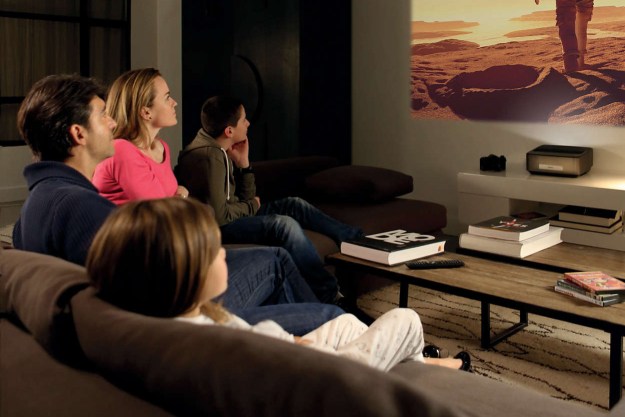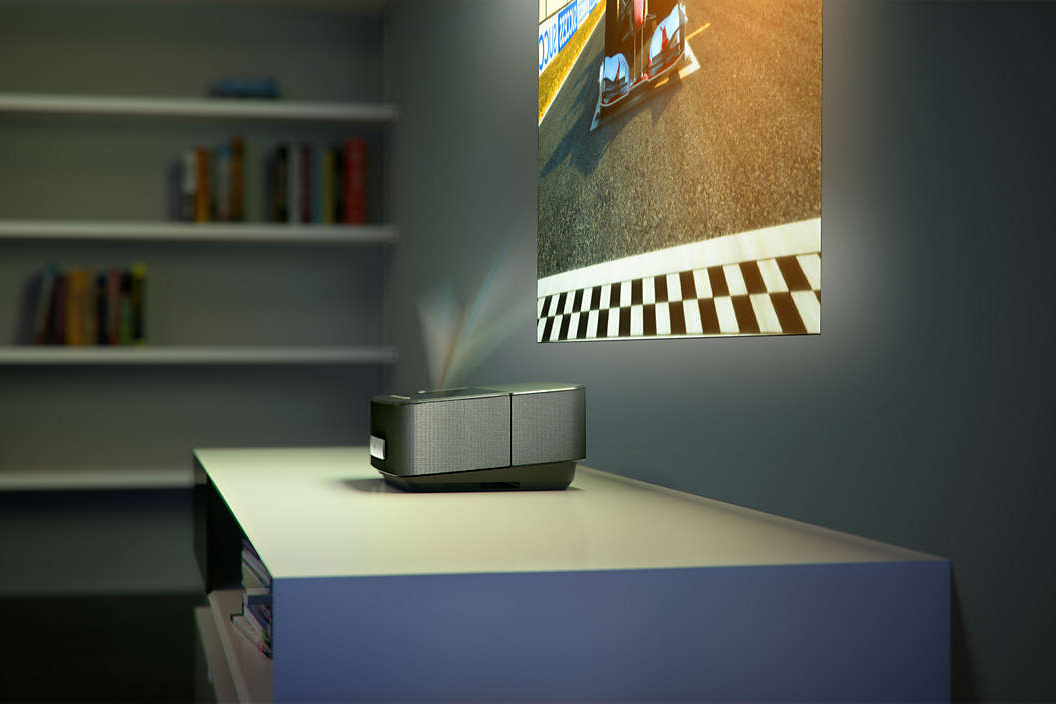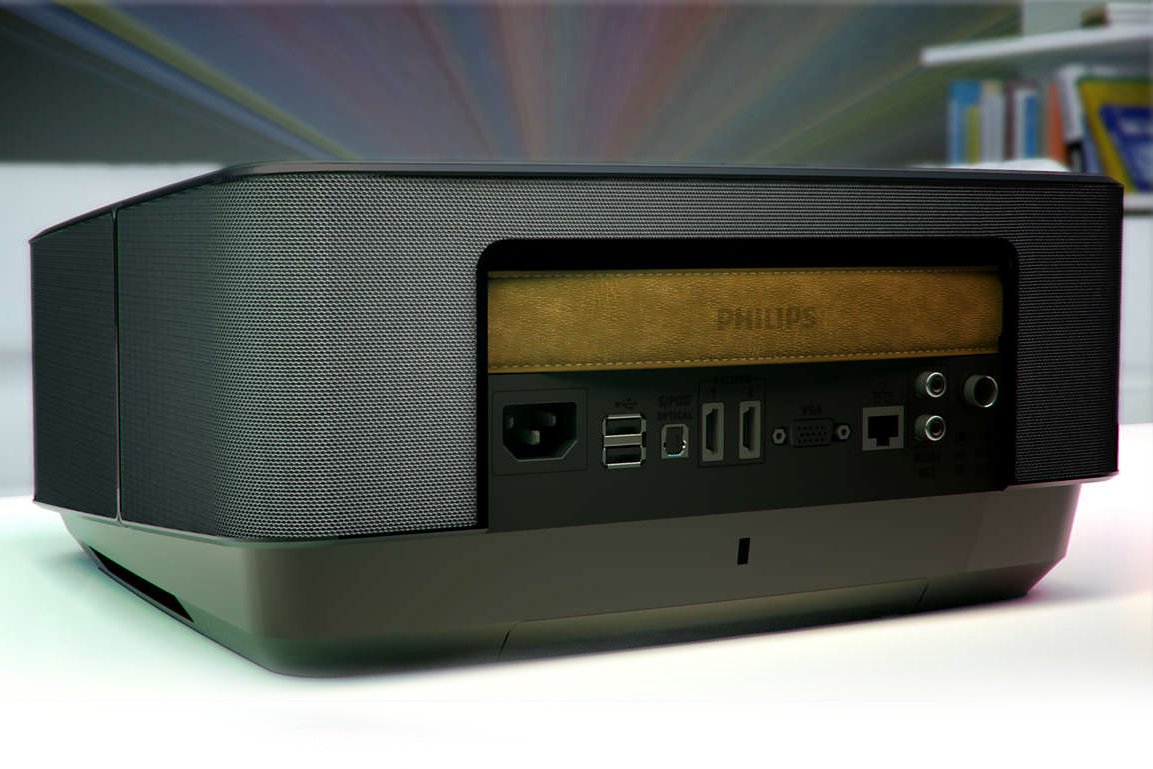
“The Screeneo transforms any wall into a huge screen from just inches away.”
- Extremely portable
- Easy setup
- Short throw distance
- Great color, decent contrast
- Built-in Wi-Fi/Bluetooth/3D/
- Constantly needs reframing
- Slight buzz in sleep mode
- Jagged corner in projection
- Expensive considering annoyances
The Philips Screeneo Smart LED projector immediately sounds like all of the fun a projector has to offer with none of the hassle that comes with it. That’s why I was so excited to use it. Any projector that touts the ability to eliminate complicated mounting issues or the need for plentiful space to get a massive picture is a winner in my book. But like most good things in life, getting what you want often requires compromise, and the Screeneo is no exception to this claim.
Although the Screeneo may seem like a niche product clinging to its ability to display image sizes from 50 – 100 – inches at 44 cm or less from the wall, this is far from its only accomplishment. With built-in speakers boasting Dolby Digital 2.1 sound, bright LED colors, and enough HDMI, USB, and plenty of other inputs on board, this projector a noteworthy option for anyone looking to go big.
Afters weeks of testing I’ve come to the conclusion that your happiness with the Screeneo projector will ultimately come down to this single question: Let’s be real… how much are you actually going to use this thing?
Out of the Box
Setting up a conventional projector can be an intimidating affair. Placement must be just right, focus and zoom must be properly balanced, then there’s the issue of getting power and signal cables to it in a discreet manner. The Screeneo dispatches with most of these complications. And straight out of the box, it’s clear that setup is going to be straight-forward.
In the box with the projector is a remote, a power cord, HDMI cable, 3D glasses, and some product literature
Setup
To my surprise, getting the Screeneo up and running is as easy as plugging in the power cable and holding the power button for 5 seconds. Just like that, it jumps to life. From here the biggest decision you’ll have to make is whether or not you’d like to place it on a table, or on the floor.
Spacing and placing the Screeneo in your living room, board room, or wherever you need it is determined by the size and height of the area you’d like to project the image on. For me, a spare bedroom with average ceilings height left me placing the projector on a small side-table, looking up at a massive 100-inch display area, easily visible from my bed. However, I did find that if you’re looking for something a bit smaller, placing it on the floor will do the trick.
From here, sliding a panel on the top of the projector down launches a game of back-and-forth tweaking. By moving the slider on the projector, you can scale and focus the image while also moving the projector to the preferred distance from the wall, resulting in the desired image location and size. All told, it took me about 2 minutes to get what I wanted — not too shabby.
Features
The Screeneo’s biggest biggest selling point is its short-throw projection. If this is what’s got you interested in buying it, you’ll be happy to hear that it works really well in this regard. But it offers more than a short throw to help solidify it’s position in the market while also coming close to earning it’s $1,5000 ($959 sale price) asking price.
The Screeneo has built-in features allowing it to act as its own source.
Unlike many projectors, the Screeneo has built-in features allowing it to act as its own source — in other words, you don’t necessarily need a cable box, Blu-ray player, or other external device to use it. With built-in Wi-Fi users can surf the web using the Screeneo’s built in browser and remote. With Miracast capabilities, it’s easy to connect a phone or tablet wirelessly and mirror screens instantly — much like an Apple TV. Lastly with built-in Bluetooth, the projector’s built-in speakers can turn the system into a sound system, albeit with some limitations. Unfortunately, outside the occasional use as a Bluetooth speaker, I found most of the Screeneo’s capabilities weren’t all that useful in everyday life.
Still, with 3 HDMI ports and USB on board, it’s easy to make the Screeneo the center of your living room or home theater because it matches the connectivity found on most modern TVs. If you want to connect an outboard audio system — say a sound bar or home theater receiver — the Screeneo’s optical digital audio output makes that possible, too.
Performance
Projectors thrive in darkness, and the Screeneo is no exception. You can see images with the lights on, sure, but this projector isn’t bright enough to battle a wealth of ambient light. Find a way to either get your room close to pitch black or wait for the sun to go down, and the LED-based projection will dazzle you with rich colors and some surprisingly decent contrast. Just remember, shadows and darker colors represent an absence of light, so the more light you have in the room, the more washed out the picture will become.
Hi-res junkies such as myself may be quick to balk at the Screeneo’s 720p output, but I must admit I didn’t even notice. When the image is scaled so large, it’s mighty impressive, and the resolution was quite crisp, too.

I binge watched two seasons of a TV show off Hulu using the Screeneo and loved every bit of it. You really feel like you’re in your own personal theater.
I just really wish darker colors had more of a presence when the lights are on but it seems like the root of the darkness comes from the darkness of the room itself. If you’re cool with watching everything in the dark, the Screeneo is great, but I just can’t see this thing ever replacing my TV.
Annoyances
I ran into a couple of issues that I personally found annoying, but wouldn’t go so far as to say are deal breakers. First, as you’ll see in the video above I experience a jagged corner in the image I got from the Screeneo. It’s unclear whether this was projection — possibly caused by the lens — or a corrupted source image. It wasn’t a big deal in the end, but if little anomalies like this bother you, you should be aware it is a potential issue.
Also, when in its sleep mode, the Screeneo generates a light buzz. In most cases, this will be a non-issue, but since I placed the projector in my bedroom, my sensitive hearing found it annoying enough that I had to unplug the projector from the wall to make it stop.
Conclusion
The Screeneo is such a hassle-free projector, you might think it would be a good replacement for a traditional TV. But, for all it can do, the Screeneo can’t change all the laws of physics. It may be able to generate an impressively huge image with just a few inches of distance from a screen, but it can’t deal with the fact that daylight kills the projector buzz. Instead of thinking of the Screeneo as a TV replacement, think of it as the most convenient way to get a theater-sized experience without most of the hassles that come with a conventional projector. Really, if there’s an easier way to set up a big-screen home theater in a pinch, we’ve yet to find it.
Editors' Recommendations
- How to create spooky Halloween effects with smart home lighting and sound
- Best outdoor projectors 2023: for backyards, camping, and more
- How to download apps on a Samsung smart TV
- Philips’ kitchen-friendly, 24-inch Android TV finally available for $299




